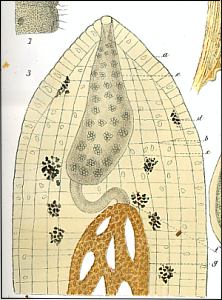Sea slugs and nematocysts
November 26, 2002
From: Asa
I'm a third grader, and while I was looking through a book on marine life I found out that Aeolid sea slugs can eat jellyfish and recycle their nematocysts.I wondered who found out that this was true, when, and how.
Asa
asag@rcn.com

ILLUSTRATION: First known illustration showing cnidosac. Trinchese, 1881: Plate 15, fig 3. 'Sacco cnidoforo' in Facelina punctata A & H [= F. annulicornis.]
Dear Asa,
Most aeolids have sacs [cnidosacs] at the tips of their cerata in which they store the nematocysts. For defence they apparently squeeze them out of a pore at the tip of their cerata. The French biologist Georges Cuvier first mentioned the internal sacs at the tips of aeolid cerata 200 years ago (1805), but it was not for another 50 years (Wright, 1859) that someone suggested that the nematocysts in the sacs were most probably obtained directly from the cnidarian food of the aeolids. This was confirmed by Grosvenor (1903). I have copied alongside the first reasonable illustration of the cnidosac. It was published by Trinchese in 1881.
If you look at the Fact Sheet on cnidosacs, and the messages below yours on this page you will see that we still have much to learn about how the nematocysts are moved, undischarged, to the aeolid, then stored, and then discharged as part of the aeolid's defence system.
Have a look at the Cerata Page on the Forum, and my message on Aeolidiopsis harrietae for a good photos of the cnidosac. Also look at the amazing Glaucus atlanticus. It chooses the most powerful of the nematocysts from its prey, and so is one of the few nudibranchs which can make a visit to the beach a nasty experience. If you are interested in other aspects of sea slug biology click on the GENERAL TOPICS button at the top of each page for an index.
References:
• Cuvier, G.L.C. (1805) Memoire sur la Scyllee, l'Eolide et le Glaucus avec des additions au memoires sur la Tritonie. Annales de Museum National d'Histoire naturelle, Paris, 6: 416-436, Pl 61.
• Grosvenor, Gilbert Hovey. (1903) On the nematocysts of aeolids. Proceedings of the Royal Society of London, 72(486): 462-486.
• Trinchese, S. (1881) Aeolididae e famiglie affini del Porto di Genova. Part 2. Anatomia, Fisiologia, Embriologia delle Phyllobranchidae, Hermaeidae, Aeolididae, Proctonotidae, Dotonidae del Porto di Genova. Memorie della Classe di scienze fisiche, matematiche e naturali, serie 3, 11: 1-142, Pls 1-80.
• Wright, T. S. 1859. [for 1858]. On the cnidae or thread-cells of the Eolidae. Proceedings of the Royal Physical Society of Edinburgh, 2: 38-40.
Best wishes,
Bill Rudman
Related messages
-
Nudibranchs and cnidarian nematocysts
From: Charlie Ellis, February 15, 2005 -
Nudibranch Predation Experiment
From: Rosemary Romero, July 15, 2003 -
Re: Nudibranch/Nematocyst interaction
From: Chad Sisson, July 9, 2000 -
Nudibranch/Nematocyst interaction
From: Annie Lindgren, July 7, 2000 -
References on defensive function of nematocysts
From: Dave Piatek, February 25, 2000
